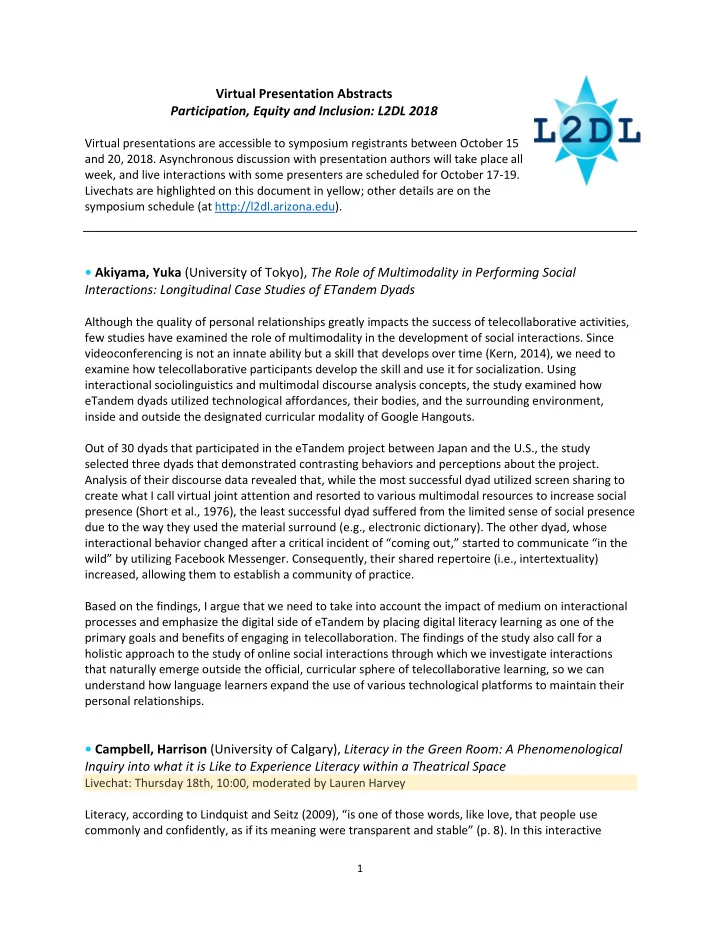

Virtual Presentation Abstracts Participation, Equity and Inclusion: L2DL 2018 Virtual presentations are accessible to symposium registrants between October 15 and 20, 2018. Asynchronous discussion with presentation authors will take place all week, and live interactions with some presenters are scheduled for October 17-19. Livechats are highlighted on this document in yellow; other details are on the symposium schedule (at http://l2dl.arizona.edu). • Akiyama, Yuka (University of Tokyo), The Role of Multimodality in Performing Social Interactions: Longitudinal Case Studies of ETandem Dyads Although the quality of personal relationships greatly impacts the success of telecollaborative activities, few studies have examined the role of multimodality in the development of social interactions. Since videoconferencing is not an innate ability but a skill that develops over time (Kern, 2014), we need to examine how telecollaborative participants develop the skill and use it for socialization. Using interactional sociolinguistics and multimodal discourse analysis concepts, the study examined how eTandem dyads utilized technological affordances, their bodies, and the surrounding environment, inside and outside the designated curricular modality of Google Hangouts. Out of 30 dyads that participated in the eTandem project between Japan and the U.S., the study selected three dyads that demonstrated contrasting behaviors and perceptions about the project. Analysis of their discourse data revealed that, while the most successful dyad utilized screen sharing to create what I call virtual joint attention and resorted to various multimodal resources to increase social presence (Short et al., 1976), the least successful dyad suffered from the limited sense of social presence due to the way they used the material surround (e.g., electronic dictionary). The other dyad, whose interactional behavior changed after a critical incident of “coming out,” started to communicate “in the wild” by utilizing Facebook Messenger. Consequently, their shared repertoire (i.e., intertextuality) increased, allowing them to establish a community of practice. Based on the findings, I argue that we need to take into account the impact of medium on interactional processes and emphasize the digital side of eTandem by placing digital literacy learning as one of the primary goals and benefits of engaging in telecollaboration. The findings of the study also call for a holistic approach to the study of online social interactions through which we investigate interactions that naturally emerge outside the official, curricular sphere of telecollaborative learning, so we can understand how language learners expand the use of various technological platforms to maintain their personal relationships. • Campbell, Harrison (University of Calgary), Literacy in the Green Room: A Phenomenological Inquiry into what it is Like to Experience Literacy within a Theatrical Space Livechat: Thursday 18th, 10:00, moderated by Lauren Harvey Literacy, according to Lindquist and Seitz (2009), “is one of those words, like love, that people use commonly and confidently, as if its meaning were transparent and stable” (p. 8). In this interactive 1
virtual presentation, I will showcase a current study, including research design and literature review, examining how literacy comes to be defined within schools and how dramatic inquiry and digital media can be used to recognize student agency, authorship, and identity within literacies definition. This study draws upon the work of the New London Group (NLG), which spoke to a growing multiplicity of communication techniques around cultural and linguistic diversities (New London Group, 1994). Moving beyond monolingual and monocultural approaches and expanding the scope of literacy pedagogy, the group proposed a framework of multiliteracies embracing multimodality and contextual responsiveness to the learning environment. Students, especially those who are English Language Learners (ELL), need to have inclusive and equitable spaces in which they can play the role of code breakers, text users and text analysts while developing literacy. Artistic inquiry and theatrical spaces in addition to teaching the aforementioned roles, also strengthen students social and cultural wellbeing (Wells & Sandretto, 2017). Theatrical spaces, are applicable not only to traditional performance halls, they are also possible within digital formats. For example, process drama which relies upon improvising original texts, interpreting texts of others, and investigating the social and cultural contexts that shape text creation are suitable modes of exploring artistic literacy representation (Pascoe, 2002, p. 70). In this study, students use a theatrical space to collectively communicate their experience of literacy and develop their own literacy practices. In my study, I argue for a shift in policy from "literacy" to "multiliteracies" through demonstrating that students' actual practices of interaction, identification, and embodiment of literacy experiences can refine educational policy (Macro, 2015). Rather than being perceived as an endpoint, it is hoped that literacy will come to be recognized an ongoing learning process integrating student agency, authorship, and identity. References : Lindquist, J., & Seitz, D. (2009). The elements of literacy . New York: Pearson Longman. Macro, K. (2015). Drama as literacy: Perceptions of an interactive pedagogy. Research in Drama Education: The Journal of Applied Theatre and Performance , 20(3), 337-339. doi:10.1080/13569783.2015.1059270 New London Group. (1996). A pedagogy of multiliteracies: Designing social futures. Harvard Educational Review , 66(1), 60. Pascoe, R. (2002). Stretching the envelope for arts literacy: Arguing for multiple literacies through drama and the other arts. Melbourne Studies in Education , 43(2), 64. doi:10.1080/17508480209556403 Wells, T., & Sandretto, S. (2017). "I'm on a journey I never thought I'd be on": Using process drama pedagogy for the literacy programme. Pedagogies: An International Journal , 12(2), 180. doi:10.1080/1554480X.2016.1245147 • Bonine, Kevin; Jill Castek, Gloria Jacobs, Jennifer Nichols, Blaine E. Smith, Leslie Sult, and Wen Wen (University of Arizona), Designing Learning Spaces that Promote Equity and Inclusion Livechat: Wednesday 17th, 10:30am, moderated by Nina Conrad In today’s educational climate, organizations are creating learning spaces for hands-on activities, often called makerspaces, co-working spaces, innovation labs, or fablabs. These spaces have evolved to be 2
Recommend
More recommend